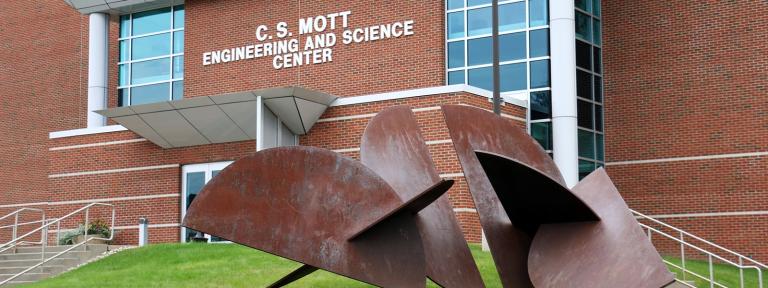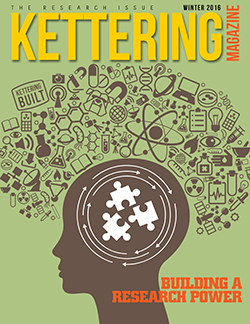
“Kettering is definitely a leader in terms of putting advanced technological tools into the hands of undergraduates.”
This story originally ran in the Winter 2016 issue of Kettering Magazine
Long recognized for excellence in applied research, Kettering University has built impressive momentum over the past three years, successfully securing more Major Research Instrumentation grants from the National Science Foundation (NSF-MRI) than any other university in Michigan – quite a coup when you consider that the competition includes three major “R-1” designated public universities. Additional federal awards from the Department of Justice, Department of Energy and U.S. Ignite, as well as significant industry and private grants, create a clear picture of Kettering as an emerging research powerhouse.
“Research really is imperative to Kettering University’s growth and success,” said Dr. James Zhang, Provost and Senior Vice President for Academic Affairs at Kettering University. “Promoting and advocating research not only aligns with and supports our mission, but is also intimately connected to our four pillars of success.”
The number of research proposals being submitted and the success rate are at an all-time high. Zhang credits the outstanding results to a focused effort on the part of an enthusiastic and engaged faculty, cross-disciplinary collaboration and quality control by people like Jill Williams in the Office of Sponsored Research, who manages the vast number of grant proposals on topics as diverse as vehicle crash safety to the anti-cancer effectiveness of modified nanoparticles.
 Most MRI Grants in Michigan:
Most MRI Grants in Michigan:
- Dr. Ronald J. Tackett (Physics) along with collaborators from multiple academic departments, received a grant to acquire a high-resolution transmission electron microscope (TEM) with energy dispersive spectroscopy capabilities to support ongoing investigations and potentially advance materials science and nanotechnology research and teaching at Kettering.
- Dr. Veronica Moorman (Biochemistry) and a team of faculty researchers received a grant that will lead to the acquisition of an isothermal titration calorimeter (ITC).
- A grant received by Dr. Yunsheng Wang (Computer Science) gives Kettering something no other university in the country has -- its own 4G long term evolution (LTE) wireless system.
- Dr. Mary Gilliam (Chemical Engineering) was the lead on a grant that brought an X-Ray Photoelectron Spectroscopy (XPS) instrument to campus.
- Dr. Prem Vaishnava (Physics) was the lead faculty member on a grant that led to the acquisition of an X-Ray Diffractometer.
- Five faculty members -- Justin Young (principle investigator), Terri Lynch-Caris, Mehrdad Zadeh, Girma Tewolde and Giuseppe Turini -- combined their research efforts to garner a grant for a motion capture system.
- Dr. Jaerock Kwon (Electrical and Computer Engineering) was the lead on a grant that led to the acquisition of a three-dimensional brain tissue scanner.
- Dr. Jonathan Wenzel (Chemical Engineering) was the principal investigator on a grant that brought a carbon, hydrogen, nitrogen, sulfur and oxygen (CHNSO) elemental determinator to augment the chemistry analytical instrument suite presently in use for research and instruction at Kettering.
Global Leadership in STEM Education
In addition to excellent academic programs and faculty, being a leader in STEM education requires access to state-of-the-art equipment. NSF-MRI grants have enabled Kettering to acquire an array of leading edge technology including an X-Ray Diffractometer, a high-resolution transmission electron microscope (TEM) and 4G LTE and WiMax wireless system. This equipment provides Kettering students with unique opportunities to participate in faculty research at the highest levels.
“Kettering is definitely a leader in terms of putting advanced technological tools into the hands of undergraduates,” said Tom Creech, Director of Sponsored Research. “Our students have opportunities they wouldn’t typically receive until the graduate level at many other institutions.”
Other efforts by Kettering faculty ensure that a broader group of students has access to this technology. One NSF grant provides scholarships to academically gifted STEM students who aren’t able to secure the financial aid to attend Kettering. Another grant supports Dr. Diane Peters, Mechanical Engineering faculty, in her research on the best way to teach non-traditional students returning to academia from the engineering workforce.
Community Vitality
When you think of Kettering and research, visions of x-ray spectrometers or 3D virtual microscopes may come to mind, but there is also a wide range of social and public safety research happening that directly impacts the Kettering community, Flint and, potentially, cities across the country. The $1 million Byrne Criminal Justice Innovation grant, a Department of Justice program, is a good example.
“We received the Byrne grant on our first application based on the fact that Kettering had already been doing so much in Flint, particularly along the University Avenue corridor,” said Jack Stock, External Relations Director. “But another driving factor was the comprehensive and collaborative research component of our proposal.”
In addition to the goal of reducing crime along the University Avenue corridor by 20 percent over three years, the initiative will study the Crime Prevention Through Environmental Design (CPTED) approach. Researchers will implement CPTED recommendations, then perform data analysis and statistical modeling to find out which measures are most effective. Learning and best practices will then be applied in other parts of Flint and across the U.S.
Kettering is working closely with officials from the city of Flint as well as colleagues from the University of Michigan-Ann Arbor, UM-Flint and Michigan State University on the project. The multi-university, cross-discipline research team includes computer science, criminal justice and liberal studies students and faculty, among others.
Engaged Stakeholders
Kettering prides itself on active and productive relationships with students, educators, alumni and community leaders, but the robust research program is especially critical to engaging another key group of stakeholders – Kettering’s 600+ active employers and industry partners. Lab-based industry sponsored projects help companies solve problems and prove out products quickly before investing on a larger scale. Relationships with industry partners help students by creating co-op learning opportunities while they attend Kettering and job placement opportunities when they graduate.
A great example of these mutual benefits is the partnership between Kettering and Shin-Etsu Chemical Company, a major global chemical and silicones supplier based in Japan. Headed by Dr. Mary Gilliam and Dr. Susan Farhat, Chemical Engineering faculty, Shin-Etsu’s four-year, $500,000 sponsorship has engaged 33 undergraduate students in research projects including the development of scratch resistant and UV-blocking coatings to help grow the applications for the company’s silicone materials.
Optimized Growth in Enrollment and Programs
Kettering’s recent rise in the college rankings from sources such as The Economist, U.S. News & World Report and the U.S Department of Education’s College Scorecard, among others – combined with enviable statistics for job placement and starting salaries show that Kettering’s unique combination of experiential learning and applied research is resonating with students and industry.
Kettering University’s 2016 entering class included nearly 500 freshmen, the most for the University in more than 10 years.
“Research is integral to Kettering’s growth strategy, a pivotal part of attracting world-class faculty and students,” Zhang said. “Research informs teaching and allows faculty members to bring cutting edge equipment and knowledge into the classroom.”